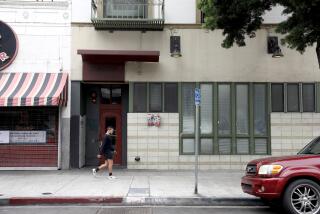No excuse for ‘patient dumping’ in L.A.’s skid row
It’s hardly news that some hospitals have engaged in “patient dumping,” the egregious practice of discharging homeless patients and simply dropping them off on the streets of skid row. Patient dumping made headlines in Los Angeles nearly a decade ago when reports of homeless people in hospital gowns and socks wandering skid row — or, in the case of a paraplegic man with a colostomy bag, crawling — prompted public outcry, city investigations of several hospitals, civil complaints and even criminal charges against Kaiser Permanente. Kaiser, which was alleged to have dropped off a homeless woman on skid row, paid fines and agreed to a groundbreaking settlement that put in place specific protocols for tracking the homeless in its hospitals, assessing their mental stability and helping find them services and lodging after discharge. Other area hospitals under investigation by the city attorney agreed to adopt similar protocols. Kaiser is now considered a model for other hospitals.
Given the universal denunciation of patient dumping from all corners of the city at that time, it’s extremely troubling to learn that it is occurring on skid row again. Or perhaps it never completely went away. Homeless advocates say they’re hearing more reports of it, but neither they nor City Atty. Mike Feuer know how prevalent patient dumping is today. Still, Feuer is smart to draw attention to even isolated cases and to work out settlements that don’t just penalize the hospitals but compel them to change their practices.
This month, Feuer announced a settlement with Beverly Hospital in Montebello after it was accused of sending a patient by taxi to skid row and leaving her on the street. Without admitting wrongdoing, the hospital agreed to pay fees of $250,000 and adopt protocols for treating and discharging the homeless. These include keeping track of their belongings and providing certain necessities (someone without shoes would be given shoes, for instance); assessing their mental and physical disabilities; attempting to locate their friends and family; bringing outpatient service providers in to consult with them; and assisting in securing suitable housing for them upon discharge. A homeless person leaving the hospital still might be sent to a shelter, but only if the hospital, the patient and the shelter staff concur in advance. In fact, Beverly Hospital agreed to a stipulation that forbids it from transporting a patient to the area of downtown around skid row unless the patient has been deemed mentally capable and chooses to go there.
These are all very good measures. But even better is Feuer’s plan to call officials of area hospitals to a meeting, in the next few months, to discuss what procedures they have in place for discharging homeless patients and to urge them to adopt protocols like those Beverly Hospital and others have agreed to in settling complaints with the city.
Feuer can’t force hospitals to adopt protocols without a cause of action. And there are already certain legal requirements hospitals must abide by when releasing any patient: There must be specific discharge plans; patients being transported elsewhere by the hospital can be taken only to their homes or to other health facilities unless they have given written consent otherwise.
But writing up and implementing a discharge plan for a patient with no home or resources and, in many cases, with a mental illness or a substance abuse problem is challenging. That’s why it’s important to have the hospitals enter into voluntary agreements with the city to follow the more detailed protocols. This wouldn’t just be good for the patients but would serve the interests of hospitals as well. The more recuperative care and service a homeless person gets after leaving the hospital, the less likely he or she is to end up at the hospital again, in worse shape, needing more intense and costly treatment.
From a humane point of view, it’s the right thing to do. “A hospital visit,” says Andy Bales, who runs the Union Rescue Mission downtown, “should be a great intervention point in interrupting a person’s homelessness.”
More to Read
Sign up for Essential California
The most important California stories and recommendations in your inbox every morning.
You may occasionally receive promotional content from the Los Angeles Times.










